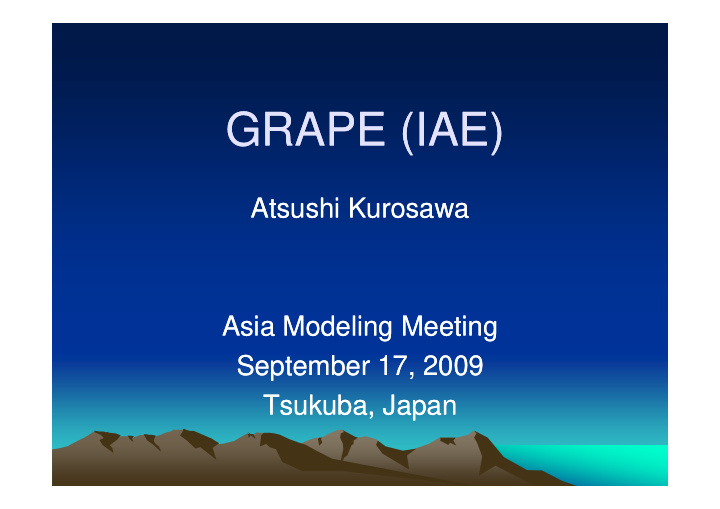



GRAPE (IAE) GRAPE (IAE) GRAPE (IAE) GRAPE (IAE) Atsushi Kurosawa Atsushi Kurosawa Asia Modeling Meeting Asia Modeling Meeting September 17 2009 September 17 2009 September 17, 2009 September 17, 2009 Tsukuba, Japan Tsukuba, Japan
Key Design Characteristics y g • Participating Model: GRAPE (Global Relationship Assessment to Protect the Environment) ) • Model Type: Integrated Assessment Model (IAM), using ISAM as its climate model • Participating Modelers: Atsushi Kurosawa • Time Step: 10 years p y • Time Frame: 2000 to 2150 • Solution Type: Intertemporal Optimization yp p p • Equilibrium Type: General Equilibrium with Macroeconomic Production Function • Underlying Computing Framework: GAMS
Inputs and Outputs p p • Key inputs – Demographics: Population by region Demographics: Population by region – Economic: Reference GDP and energy demand, other parameters in CES production function (e.g. elasticities, TFPs) TFPs) – Resources: Depletable resource by grade (e.g. fossil fuel and uranium); renewable resource by grade (e.g. biomass, hydropower) or price down over time(e g wind solar) hydropower) or price down over time(e.g. wind, solar) – Technology: Energy conversion (e.g. generation, hydrogen, synfuel) and CCS, enduse products (vehicle, CHPs, FCs) • Key outputs – Economic: GDP, investment, consumption – Energy: Production, conversion, enduse and trade – Agriculture: Production, landuse, food demand – Emissions: CO2, nonCO2(CH4, N2O, F-gases), other agents Emissions: CO2, nonCO2(CH4, N2O, F gases), other agents – Climate: GHG conc., radiative forc., temperature, etc.
Regional Scope & Other Detail g p • Regional Details: – Regional Scope: Global – Number of Sub-Regions: 15 – Asian Regions: Japan, China, India, Southeast Asia • Other Details: Oth D t il – Energy Demand Sectors : Transportation, Electricity, St ti Stationary – Climate and CO2 feedbacks to Terrestrial Biosphere
Asian Baselines Power Generations JAPAN JAPAN CHINA CHINA Power Generation (JPN) Power Generation (CHN) 1400 20000 SOL PV SOL PV 18000 WIND WIND 1200 16000 BIO BIO HYDGEO HYDGEO HYDGEO HYDGEO 1000 1000 14000 FBR FBR 12000 NUCL NUCL 800 (TWh) (TWh) H2 H2 10000 NG NG 600 8000 CTL CTL 6000 OIL OIL 400 IGCC IGCC IGCC IGCC 4000 COAL COAL 200 2000 0 0 2000 2010 2020 2030 2040 2050 2060 2070 2080 2090 2100 2000 2010 2020 2030 2040 2050 2060 2070 2080 2090 2100 Southeast ASIA Southeast ASIA INDIA INDIA Power Generation (SEA) Power Generation (IND) 14000 10000 SOL PV SOL PV 9000 WIND WIND 12000 8000 BIO BIO HYDGEO HYDGEO HYDGEO HYDGEO 10000 10000 7000 7000 FBR FBR 6000 NUCL NUCL 8000 (TWh) (TWh) H2 H2 5000 NG NG 6000 4000 CTL CTL OIL 3000 OIL 4000 IGCC IGCC IGCC IGCC 2000 COAL COAL 2000 1000 0 0 2000 2010 2020 2030 2040 2050 2060 2070 2080 2090 2100 2000 2010 2020 2030 2040 2050 2060 2070 2080 2090 2100
Previous Work on Asia Energy Innovation Analysis “Cool Earth - Innovative Energy Technology Program” gy gy g 21 key innovative energy technologies. Efficiency improvement Low carbonization Power Generation Supply si 3. CCS 4.I nnovative solar power 2. Efficient coal-fired power plant 5. Advanced nuclear 1. Efficient 1. Efficient ide power LNG-fired power plants 6. Superconducting power transmission 9. PHEV/ EV 7. I TS Transport 8. FCV 10. Biofuel Demand sid D I ndustry 11. I nnovative materials/ 12. Steel making manufacturing process process with Hydrogen de Residences/ Residences/ 15 F 15. Fuel cells for l ll f 14. Efficient 13. Efficient Buildings residential use lighting houses/ buildings 16. Efficient 17. Efficient I T 18. HEMS/ BEMS/ Heat pumps devices/ networks devices/ networks Regional EMS Regional EMS Cross-cutting 21. Hydrogen 19. Power 20. Power 3. CCS production/ storage/ 5 storage electronics ( restated) transport
Previous Work on Asia Sustainable Biofuel Use – Conceptual Study Biomass Utilization System Definition * Boundary * Timeframe * Other Conditions Resource Resource * Biomass Resource * Land Use Competition *Water Resource Society Energy Conversion * International Cooperation * Technologies * Energy Security * Energy Demand * Standards * Supply Stability Supply Stability * O h * Other Social Factors S i l F Environment Economy * LCA * Utilization System Cost * Biodiversity Source: ERIA Project Report, 2007
Previous Work on Asia Synfuel Analysis – CTL and Biofuel Power Methane Generation Natural CNG LPG Gas Vehicles LPG Gasoline Vehicles Crude MTG Gasoline Oil Vehicles Transportation FT Oil Diesel Vehicles Conversion Conversion Diesel Airplane COAL Heavy Oil Marine Methanol DME Ethanol Ethanol Stationary Stationary Biomass Biomass BDF
Recommend
More recommend